

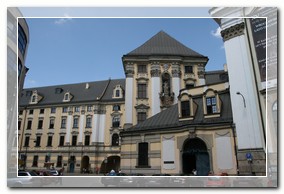
 he Main Edifice of
the University of Wroclaw is one of the most important monuments of the
city, a real baroque pearl. The school, which served as a base from the
beginning of it's existence was founded by Leopold I Habsburg on 21st
October 1702, as a Jesuit's academy with two departments — theological
and philosophical. It's history could have begun 200 years earlier,
because in the year 1505 Wladyslaw Jagiellonczyk, Czech and Hungarian
king, established in Buda a foundational document of the university in
Wroclaw. It was however protested by the only university in Poland —
University of Cracow, which was successful in convincing
he Main Edifice of
the University of Wroclaw is one of the most important monuments of the
city, a real baroque pearl. The school, which served as a base from the
beginning of it's existence was founded by Leopold I Habsburg on 21st
October 1702, as a Jesuit's academy with two departments — theological
and philosophical. It's history could have begun 200 years earlier,
because in the year 1505 Wladyslaw Jagiellonczyk, Czech and Hungarian
king, established in Buda a foundational document of the university in
Wroclaw. It was however protested by the only university in Poland —
University of Cracow, which was successful in convincing 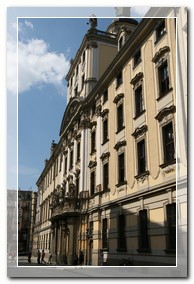 the pope Julius II
to a refusal of the confirmation of the document. This is why the
University fo Wroclaw has come into existance just a bit over three
hundred years ago, which makes from it the oldest college on Silesia and
after the Jagellonian University in Cracow the oldest university in
Poland.
the pope Julius II
to a refusal of the confirmation of the document. This is why the
University fo Wroclaw has come into existance just a bit over three
hundred years ago, which makes from it the oldest college on Silesia and
after the Jagellonian University in Cracow the oldest university in
Poland.
The corner stone under the present Main Edifice of the University of Wroclaw was built in on 6th December 1728 in a place of the earlier demolished mediaeval piast's castle. The building was fully sponsored by the emperor Leopold I and his successors. The original project stated a construction of a baroque building long for over 200 metres. From the original plan of three towers, only the lower, called the Mathematical Tower was built, however its identical twin tower and the highest central tower were not built, because of the financial problems resulting from the explosion of the seven year war. The trunk itself was finished only in about 2/3 (the part of the eastern wing was not finished) and it has got the length of 171 m, what makes from it the longest baroque facade in the world.
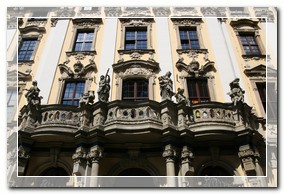 In the row of
windows a special attention is paid mostly to the main entry to the
University, beautifully adorned, and situated over it a balcony portico
with allegorical sculptures presenting four cardinal virtues, which
every student of the university should have: bravery, discernment,
constancy and moderately, holding a pitcher full of wine. Unfortunately
this last virtue tends to be traditionally treated by students of the
University a bit lightly, what is testified by the history of the
sculpture of the nude Fencer, which stands in front of the Main Edifice.
In the row of
windows a special attention is paid mostly to the main entry to the
University, beautifully adorned, and situated over it a balcony portico
with allegorical sculptures presenting four cardinal virtues, which
every student of the university should have: bravery, discernment,
constancy and moderately, holding a pitcher full of wine. Unfortunately
this last virtue tends to be traditionally treated by students of the
University a bit lightly, what is testified by the history of the
sculpture of the nude Fencer, which stands in front of the Main Edifice.
When we enter through the main portal to the hall of the University,
the splendour of the interiors hits us, particularly the exquisite
frescoes. On the left from the entrance, in the Longchamp hall, we can
watch the exposition devoted to the history of the University. On the
right from the entrance a musical hall is situated, Oratorio Marianum,
partly destroted in the time of war, restored during the breakthrough of
the XX and the XXI century. However, the true baroque pearl awaits us on
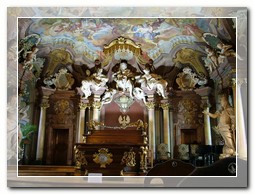 the first floor.
This is the Leopoldin Hall, named on the worship of the founder of the
University representative hall full of splendour. Over the auditorium a
great allegorical fresco of the authorship of Johan Christoph Handke
represents the apotheosis of God's Wisdom and the personifications of
sciences and arts. Smaller frescoes in the window niches represent
prominent scholars living since the ancient times till the XVII century.
The magnificent fresco over the podium portrays the sacrifice of the
University to the Mother of God. A sculptured group of figures is also
situated over the podium: the emperor Leopold I on a throne sits in the
centre, there are personifications of virtues at both of his sides: an
old man with a mirror (discernment) and a woman with a hive
(providence), meanwhile below the emperor rejected by him faults are
shown: quarrel (a woman with the hair in disarrays) and foolishness
(young man with donkey ears). The statues of Leopold's sons are disposed
on both sides of the podium, under the columns, but also the emperors
Joseph I and Charles VI. Sixteen portraits of people well-earned for the
order of Jesuits and during the building of the university adorn the
hall. Eight of these portraits were stolen in 1997, one was retrieved,
the rest were replaced with copies. It is worth to pay the attention on
the richly adorned entrance portal to the Hall with beautifully carved
door.
the first floor.
This is the Leopoldin Hall, named on the worship of the founder of the
University representative hall full of splendour. Over the auditorium a
great allegorical fresco of the authorship of Johan Christoph Handke
represents the apotheosis of God's Wisdom and the personifications of
sciences and arts. Smaller frescoes in the window niches represent
prominent scholars living since the ancient times till the XVII century.
The magnificent fresco over the podium portrays the sacrifice of the
University to the Mother of God. A sculptured group of figures is also
situated over the podium: the emperor Leopold I on a throne sits in the
centre, there are personifications of virtues at both of his sides: an
old man with a mirror (discernment) and a woman with a hive
(providence), meanwhile below the emperor rejected by him faults are
shown: quarrel (a woman with the hair in disarrays) and foolishness
(young man with donkey ears). The statues of Leopold's sons are disposed
on both sides of the podium, under the columns, but also the emperors
Joseph I and Charles VI. Sixteen portraits of people well-earned for the
order of Jesuits and during the building of the university adorn the
hall. Eight of these portraits were stolen in 1997, one was retrieved,
the rest were replaced with copies. It is worth to pay the attention on
the richly adorned entrance portal to the Hall with beautifully carved
door.
A part of antique interiors, particularly he Senate Hall and the Rector office, is not accessible for the public, however passing on the second end of the building to the university cafe is worth the time, formerly the monastic drugstore, to admire the beautifully carved wooden entrance portal and picturesque frescoes in the club.
One should mark, that as every respecting three hundred year
building, the University has it's spirit, inherited after the formerly
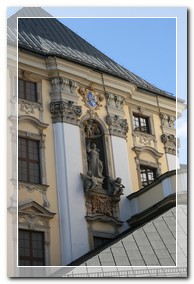 standing in this place mediaeval castle. The legend says, that the
castellan of the castle, great brute, adored to torture his prisoners
with the help of „Iron Virgin”, the sarcophagus equipped in sharp thorns
placed on the internal side of the fixed hatches, which stuck in the
body of the tortured in the measure of closing the device, wounding
painfully, however not violating the important for life organs. It was
said, that nobody survived the claspof the Iron Virgin, prisoners died
slowly and in tortures from the outflow of the blood. The cruel
castellan had a daughter, beautiful and noble Elisabeth, who loved
mutually loved a young man from Wroclaw. Bad luck wanted that this young
man had fallen for some small offence in the hands of the castellan, who
instantly had chosen for him the death in the clasp of the Iron Virgin.
Elisabeth could not bear this. Late at night she stole the keys from her
father and ran over to save her beloved from the dungeons. However the
tyrant woke up, noticed his daughter's betrayal, took a dagger and ran
over after her. There was a welter, in result of which the castellan
reeled and fell in the Iron Virgin's clasps. The lid slammed shut, and
blood sailed out from the cracks. Before he died, he cursed however the
daughter, who from this time every night wanders through the corridors
of the old edifice, sighing from the sorrow too the young man, with whom
the paternal curse divided her for all times.
standing in this place mediaeval castle. The legend says, that the
castellan of the castle, great brute, adored to torture his prisoners
with the help of „Iron Virgin”, the sarcophagus equipped in sharp thorns
placed on the internal side of the fixed hatches, which stuck in the
body of the tortured in the measure of closing the device, wounding
painfully, however not violating the important for life organs. It was
said, that nobody survived the claspof the Iron Virgin, prisoners died
slowly and in tortures from the outflow of the blood. The cruel
castellan had a daughter, beautiful and noble Elisabeth, who loved
mutually loved a young man from Wroclaw. Bad luck wanted that this young
man had fallen for some small offence in the hands of the castellan, who
instantly had chosen for him the death in the clasp of the Iron Virgin.
Elisabeth could not bear this. Late at night she stole the keys from her
father and ran over to save her beloved from the dungeons. However the
tyrant woke up, noticed his daughter's betrayal, took a dagger and ran
over after her. There was a welter, in result of which the castellan
reeled and fell in the Iron Virgin's clasps. The lid slammed shut, and
blood sailed out from the cracks. Before he died, he cursed however the
daughter, who from this time every night wanders through the corridors
of the old edifice, sighing from the sorrow too the young man, with whom
the paternal curse divided her for all times.












